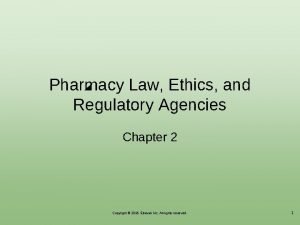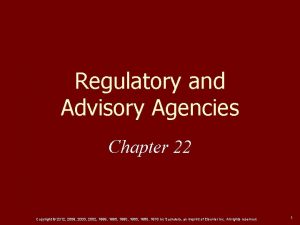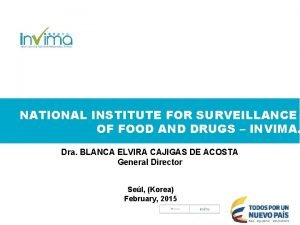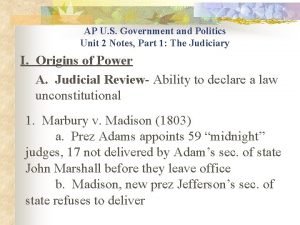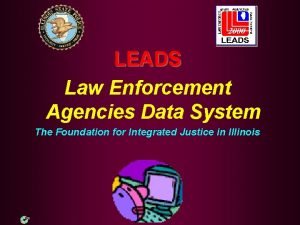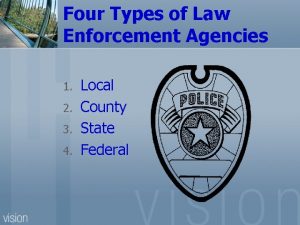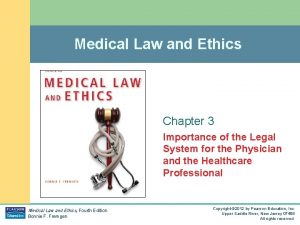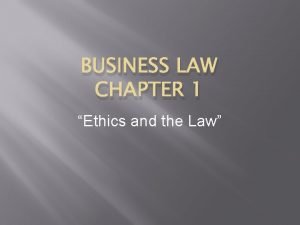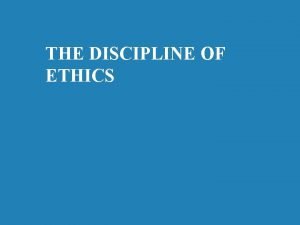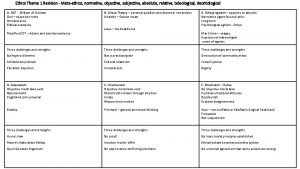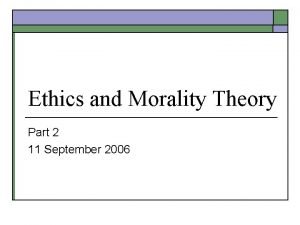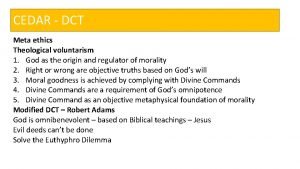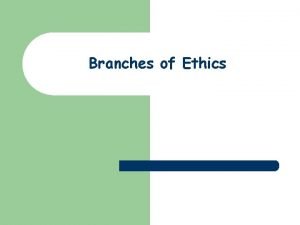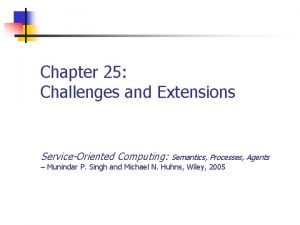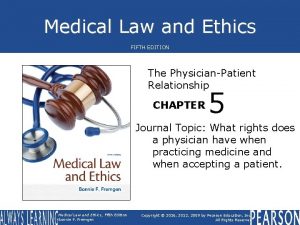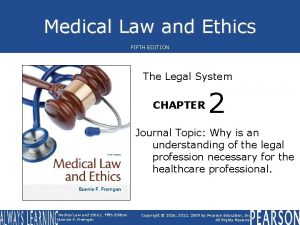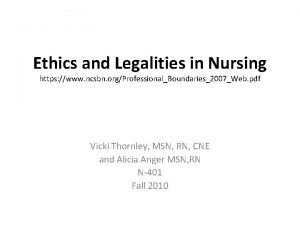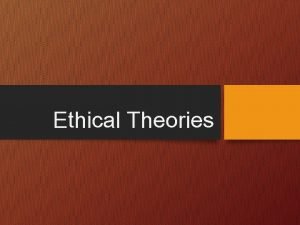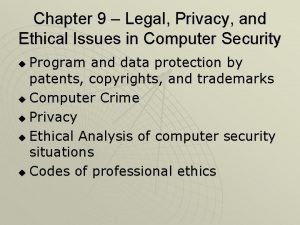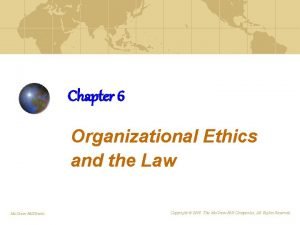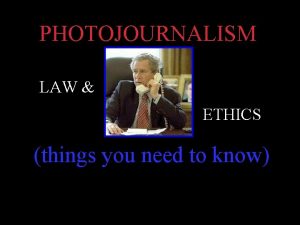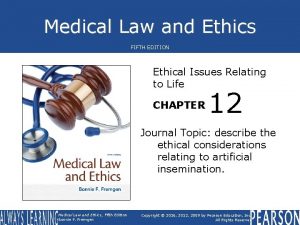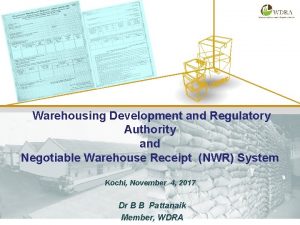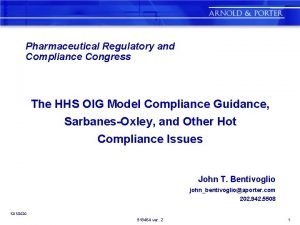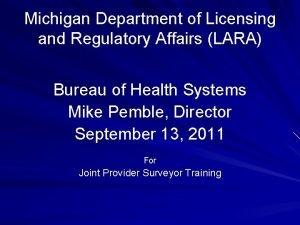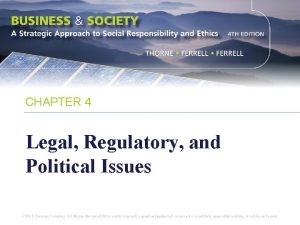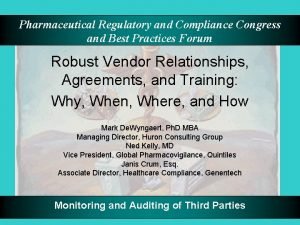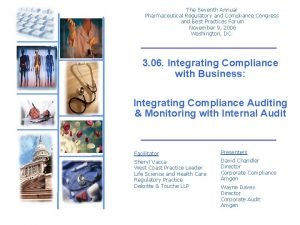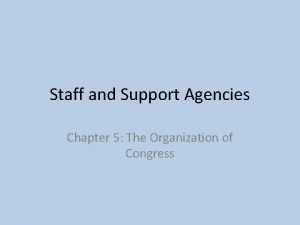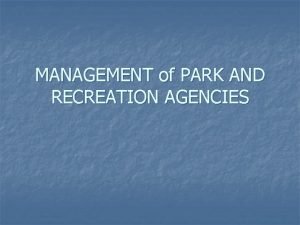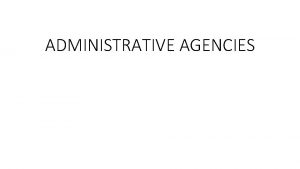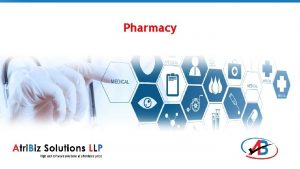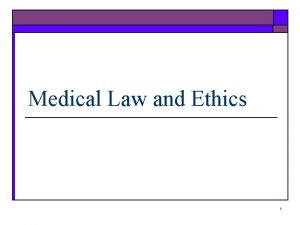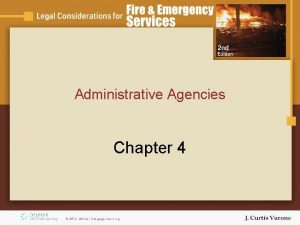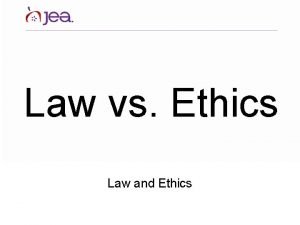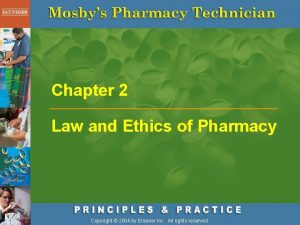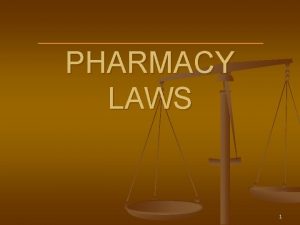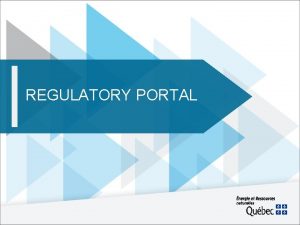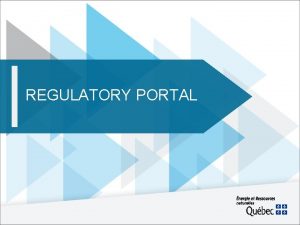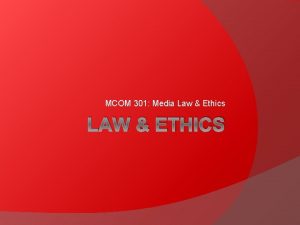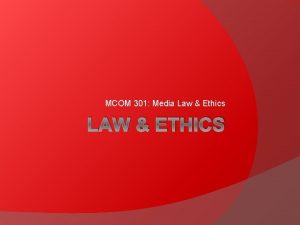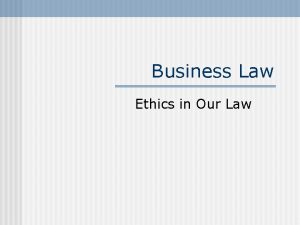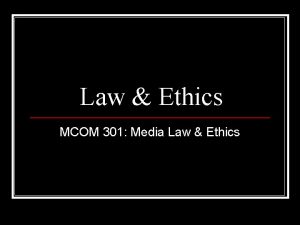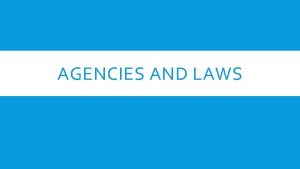Pharmacy Law Ethics and Regulatory Agencies Chapter 2






















































- Slides: 54

Pharmacy Law, Ethics, and Regulatory Agencies Chapter 2 Copyright © 2016, Elsevier Inc. All rights reserved. 1

Lesson 2. 1 Federal Laws Affecting the Pharmacy Technician and Functions of the FDA and DEA � � � List the history of federal drug laws in chronological order. Describe the implications of the Health Insurance Portability and Accountability Act (HIPAA). Explain how the Patient Protection and Affordable Care Act (ACA) and the Drug Quality and Security Act (DQSA) have changed health care. Define the functions of the Food and Drug Administration (FDA) and Drug Enforcement Administration (DEA). Describe the process for reporting any problems with a drug or any adverse reactions to the FDA. Explain the three classes of drug recalls defined by the FDA. Copyright © 2016, Elsevier Inc. All rights reserved. 2

History of the FDA is important in pharmacy � FDA is under the direction of the Department of Health and Human Services � FDA’s main function: Enforce guidelines for manufacturers to ensure safety and effectiveness of medications � Copyright © 2016, Elsevier Inc. All rights reserved. 3

1906 ‒ Pure Food and Drug Act Enacted to stop the sale of inaccurately labeled drugs � Manufacturers were required to: � Provide truthful information on the label before a drug was sold ➢ Prove the drug’s effectiveness ➢ Copyright © 2016, Elsevier Inc. All rights reserved. 4

1914 ‒ Harrison Narcotics Act � Enacted to curb recreational use of opium No longer available without a prescription ➢ Records required for prescriptions ➢ Importation and distribution were restricted ➢ Copyright © 2016, Elsevier Inc. All rights reserved. 5

1938 ‒ Food, Drug, and Cosmetic Act Enacted because the 1906 law was not worded strictly enough and did not include cosmetics � Required drug companies to include directions to the consumer regarding use of a drug, and also package inserts � All addictive substances had to be labeled: “Warning: May be habit forming” � Copyright © 2016, Elsevier Inc. All rights reserved. 6

1938 ‒ Food, Drug, and Cosmetic Act Defined the exact labeling for products and defined misbranding and adulteration as illegal � Requires the following: � Mandatory food labeling ➢ Standards of identity ➢ Information on imitation foods ➢ Nutritional information for special dietary foods ➢ � Provided the legal status for the Food and Drug Administration (FDA) Copyright © 2016, Elsevier Inc. All rights reserved. 7

1951 ‒ Durham-Humphrey Amendment Required label on prescription drugs: “Caution: Federal law prohibits dispensing without a prescription. ” � Required a doctor’s order and supervision for certain drugs � Made the initial distinction between legend drugs (by prescription only) and OTC medications that do not require a doctor's order (non-prescription drugs) � Copyright © 2016, Elsevier Inc. All rights reserved. 8

1962 ‒ Kefauver-Harris Amendments Enacted in an attempt to ensure the safety and effectiveness of all new drugs on the market � Burden put on manufacturers to ensure “good manufacturing practice” (GMP) � Prevented the sale of thalidomide in the United States; children in Europe were born with birth defects after mothers used drug during pregnancy � Copyright © 2016, Elsevier Inc. All rights reserved. 9

1970 ‒ Comprehensive Drug Abuse Prevention and Control Act Established the Drug Enforcement Administration (DEA) to enforce the laws covering controlled substances and their distribution � Created stair-step categories of controlled substances (Schedules I-V) � Copyright © 2016, Elsevier Inc. All rights reserved. 10

1970 ‒ Poison Prevention Packaging Act � Required all medications to be placed in containers with childproof caps or packaging ➢ � Includes both OTC and legend drugs Exceptions include: Physician request for non-childproof cap ➢ Certain legend medications ➢ Hospitalized patients or patient request ➢ Copyright © 2016, Elsevier Inc. All rights reserved. 11

1983 ‒ Orphan Drug Act and 1987 ‒ Prescription Drug Marketing Act Orphan Drug Act: Eased restrictions (and thus costs) for development of new drugs for those with a rare disease (affecting 1 in 200, 000 people) � Prescription Drug Marketing Act � Helps prevent counterfeit drugs and ingredients from entering the supply chain ➢ Limits diversion of pharmaceutical samples and prescription drugs ➢ Copyright © 2016, Elsevier Inc. All rights reserved. 12

1990 ‒ Omnibus Budget Reconciliation Act (OBRA ’ 90) Deals specifically with practicing pharmacists � Enacted because of reimbursement regulations for people who are covered by Medicaid or Medicare � Requires pharmacists to counsel (at the time of purchase) all patients who receive new prescriptions � Copyright © 2016, Elsevier Inc. All rights reserved. 13

1996 ‒ Health Insurance Portability and Accountability Act (HIPAA) Deals with patient’s right to continuance of health insurance even when changing employers � Change for pharmacies: Pharmacists and technicians have direct knowledge of a patient’s medical information; the patient must sign a consent form to grant others access to this information � Copyright © 2016, Elsevier Inc. All rights reserved. 14

Patient Confidentiality Prevents privileged information about a customer from being disclosed without his or her consent � Changes have been made throughout all medical facilities and medical information centers that limit access to patient information � All individually identifiable health information is protected � Pertains to information in any form or media � Copyright © 2016, Elsevier Inc. All rights reserved. 15

Public Health Activities � PHI may be disclosed to: Public health authorities ➢ Entities subject to FDA regulation ➢ Those who have been exposed to a communicable disease ➢ Employers regarding work-related illness/injury to comply with OSHA ➢ Copyright © 2016, Elsevier Inc. All rights reserved. 16

Law Enforcement Purposes � PHI may be disclosed to law enforcement officials: As required by law (for example, court orders) ➢ To identify or locate a suspect, fugitive, material witness, or missing person ➢ To provide information about a victim ➢ If criminal activity caused a victim’s death ➢ Copyright © 2016, Elsevier Inc. All rights reserved. 17

2000 ‒ Drug Addiction Treatment Act (DATA 2000) � Physicians can prescribe controlled substances to persons suffering from opioid addiction ➢ Only for maintenance or detoxification treatments Copyright © 2016, Elsevier Inc. All rights reserved. 18

2003 ‒ Medicare Modernization Act � Provides a drug discount card to those with low incomes who require assistance from a pharmacy company to obtain medications Copyright © 2016, Elsevier Inc. All rights reserved. 19

2005 ‒ Combat Meth Act Addresses all areas of the manufacture and sale of pseudoephedrine (an ingredient used to make methamphetamine), as well as law enforcement � Strict guidelines � ➢ Only a licensed pharmacist or technician may dispense, sell, or distribute this drug 2005 ‒ Combat Meth Act Copyright © 2016, Elsevier Inc. All rights reserved. 20

2010 ‒ ACA and 2013 ‒ Drug Quality and Security Act � Patient Protection and Affordable Care Act (ACA): Two important technician-related components: Electronic health records (EHR) ➢ Medication therapy management (MTM) ➢ � Drug Quality and Security Act (DQSA) ➢ FDA tracking system for bulk compounding supplies Copyright © 2016, Elsevier Inc. All rights reserved. 21

Functions of the FDA and DEA � FDA ➢ Enforces guidelines for manufacturers to ensure safety and effectiveness of medications • � Anything that contains any avoidable, poisonous, or harmful substance is considered unsafe DEA Prevents illegal distribution and misuse of controlled substances ➢ Issues licenses and enforces the nation’s drug laws ➢ Copyright © 2016, Elsevier Inc. All rights reserved. 22

FDA Reporting Process and Adverse Reactions 1 -800 -FDA-1088: Toll-free number for reporting any defect in OTC medications and any other drug problems � Should report: Any medication reaction that might cause disability, hospitalization, or death � Patient’s identity must be kept confidential � Copyright © 2016, Elsevier Inc. All rights reserved. 23

FDA Reporting Process and Adverse Reactions � Med. Watch: FDA program that allows consumers and health care professionals to report any discrepancies or adverse reactions to medications Copyright © 2016, Elsevier Inc. All rights reserved. 24

Recalled Drugs � Three classes of recalls: Class 1: Products that could cause serious harm or prove fatal ➢ Class 2: Products found to cause a temporary health problem or pose a slight threat of serious harm ➢ Class 3: Products that may have a minor defect or other condition that would not harm the patient ➢ Copyright © 2016, Elsevier Inc. All rights reserved. 25

Lesson 2. 2 Controlled Substances, Drug Warnings, Prescribing Medications, and Pharmacy Guidelines 7. 8. 9. 10. 11. 12. 13. 14. Describe the proper handling of controlled substances. Explain the necessary forms and regulations used for controlled substances. List the basic information contained in a drug monograph. Explain the purpose of boxed warnings and Med. Guides. List and explain the five pregnancy categories established by the FDA. List who can prescribe medications and medical devices. Describe prescription orders and prescription labels. Perform the function of verifying a DEA number. Copyright © 2016, Elsevier Inc. All rights reserved. 26

Lesson 2. 2 Controlled Substances, Drug Warnings, Prescribing Medications, and Pharmacy Guidelines 15. 16. 17. 18. 19. 20. Explain the purpose of risk management programs for prescription drugs. Explain the verification process for Internet pharmacies. Explain the Occupational Safety and Health Administration (OSHA) guidelines as they pertain to pharmacy. Explain the purpose of the Joint Commission. Explain why pharmacy technicians must be knowledgeable about the law when performing nondiscretionary duties. Discuss the differences between morals and ethics. Copyright © 2016, Elsevier Inc. All rights reserved. 27

Controlled Substances � Commonly known as narcotics and are addictive ➢ � Opium comes from the poppy seed plant and has analgesic effects and also affects mood and behavior ➢ � Narcotics are derived from opium or opium-like substances Opioids, such as codeine and morphine, are substances created from opium Each type of narcotic is assigned a rating that depends on its addictive and abuse potential Copyright © 2016, Elsevier Inc. All rights reserved. 28

Ratings of Scheduled (Controlled) Substances � Five levels based on potential for abuse: C-I: Strongest potential for abuse; no medicinal use in the United States (for example, LSD, heroin) ➢ C-II, C-IV, C-V: All medicinal narcotic drugs ➢ C-V: Kept OTC in some states because of low potential abuse ➢ C-II: Must be locked up because of high potential abuse ➢ � U. S. Attorney General assigns the schedule for a drug Copyright © 2016, Elsevier Inc. All rights reserved. 29

Tamper-Proof Prescriptions � New scripts have up to eight different tamperproof security marks on them ➢ Prevents forgery and fraud Copyright © 2016, Elsevier Inc. All rights reserved. 30

Registration Required for Maintaining Narcotics � DEA has four main registration forms: Form 224: Needed by pharmacy to dispense controlled substances ➢ Form 225: To manufacture or distribute controlled substances ➢ Form 363: To run a narcotic treatment program or compound narcotics ➢ Form 41: Returns to reverse distributor ➢ Copyright © 2016, Elsevier Inc. All rights reserved. 31

Refilling Controlled Substances � Strict guidelines Drugs rated C-III through C-V can be refilled a maximum of five times or within 6 months of the original order, whichever comes first ➢ Record must be kept with pharmacist’s initials and date drug was dispensed ➢ Copyright © 2016, Elsevier Inc. All rights reserved. 32

Ordering Controlled Substances Pharmacy obtains C-II substances from a distributor � Form 222 must be filled out by the receiving pharmacy in pen, typewriter, or indelible pencil � Top copy and middle copy with carbon paper are sent to the supplier or manufacturer � Copyright © 2016, Elsevier Inc. All rights reserved. 33

Ordering Controlled Substances Top and middle copies with carbon paper are returned to distributor or wholesaler � Filing electronically is also possible (but not for C-II drugs) � Pharmacy retains bottom copy � ➢ Invoice and form are retained for 7 years Copyright © 2016, Elsevier Inc. All rights reserved. 34

Ordering Controlled Substances � Drugs rated C-III, C-IV, or C-V Ordered on normal invoice forms but must be filed and retained for DEA or board of pharmacy (BOP) inspection ➢ Should be kept separate from other nonscheduled drugs ➢ Forms kept for 2 years ➢ Copyright © 2016, Elsevier Inc. All rights reserved. 35

Record Keeping � Three methods of filing controlled substances ➢ � In some states, the BOP may require a specific method Controlled substances must be logged out of pharmacy stock before being issued ➢ Double-check the remaining stock Copyright © 2016, Elsevier Inc. All rights reserved. 36

Narcotic Inventory Perpetual inventory � Pharmacist must validate all counts done by a technician � Discrepancies are investigated by DEA � Copyright © 2016, Elsevier Inc. All rights reserved. 37

Reverse Distributor � All controlled substances that are unwanted, unusable, or outdated that are returned to the distributor ➢ Prevents drug diversion Copyright © 2016, Elsevier Inc. All rights reserved. 38

Filling, Refilling, and Transferring Prescriptions for Controlled Drugs Original fill of C-II through C-V: Written, oral, or fax � Emergency C-II original fill: Oral order only in emergency situations � Refills of C-II through C-V: � C-II: No refills ➢ C-III and C-IV: 5 times within 6 months ➢ C-V: No restrictions ➢ Copyright © 2016, Elsevier Inc. All rights reserved. 39

Partial Filling of C-II Through C-V � � � C-III, C-IV, and C-V: Must have remainder dispensed within 6 months C-II: Must have remainder dispensed within 72 hours Transfer of prescriptions C-II through C-V: May be transferred only once Some states require Schedule V drugs to be dispensed by a pharmacist Controlled substances C-II through C-V may be mailed as long as contents are not identified on packaging Copyright © 2016, Elsevier Inc. All rights reserved. 40

Monographs/Package Inserts � � Contained in the Physicians’ Desk Reference (PDR) in doctor’s office and Facts and Comparisons in pharmacy Includes: Description, clinical pharmacology, indications and usage, contraindications, warnings, precautions, drug abuse and dependence, adverse reactions, dosage, and how supplied Boxed warning (also called Black Box Warning) Med. Guides: Printouts required for certain medications Copyright © 2016, Elsevier Inc. All rights reserved. 41

Pregnancy Categories � FDA established five categories to identify a drug’s potential harm to a fetus or pregnant woman Category X: Not to be used during pregnancy ➢ Category A: No evidence of harm based on studies ➢ Categories B-D: Various levels of risk ➢ Copyright © 2016, Elsevier Inc. All rights reserved. 42

Prescription Regulations � Who can prescribe? ➢ FDA and DEA have no authority to determine prescribers Prescribers are licensed by their individual state boards � Standard practitioners in all 50 states are physicians, surgeons, doctors of osteopathy, dentists, podiatrists, veterinarians, and optometrists � Copyright © 2016, Elsevier Inc. All rights reserved. 43

Who Can Receive a Prescription? Pharmacy technicians take in prescriptions, interpret them, and fill them � Technicians cannot take phone orders � Pharmacists give the final check, take verbal telephone orders, and transfer prescriptions to another pharmacy � Copyright © 2016, Elsevier Inc. All rights reserved. 44

Prescription Labels � � The information on a prescription label differs from a prescription order Two necessary components are pharmacy information and patient information Special labeling sometimes is required because of adverse effects or the possibility of teratogenicity to an unborn fetus Labels include: Name, address, and phone number of the pharmacy; name of prescriber and date prescription was filled; prescription number and cautions Copyright © 2016, Elsevier Inc. All rights reserved. 45

Repackaging � Medication taken from bulk packages and placed into blister packs or unit-dosing devices must include: Drug name ➢ Strength and dosage form ➢ Manufacturer and lot number ➢ Expiration date ➢ Copyright © 2016, Elsevier Inc. All rights reserved. 46

DEA Verification � � All prescribers must be registered with the DEA to write prescriptions for controlled substances Prescribers are given a nine-character identification code, which is different for each prescriber First two characters are letters: A or B, followed by the first letter of the prescriber’s last name Next seven digits are composed of numbers added together Copyright © 2016, Elsevier Inc. All rights reserved. 47

Special Prescribing Programs � Programs for opioid maintenance: Methadone maintenance treatment (MMT) ➢ Suboxone and Subutex ➢ � Risk management programs for prescription drugs: ➢ i. Pledge Program Copyright © 2016, Elsevier Inc. All rights reserved. 48

Pharmacy Sites Brick and mortar stores � Mail-order pharmacies � E-pharmacies � National Association of Boards of Pharmacies (NABP) verifies these sites but does not regulate them ➢ Potential for illegally ordered drugs ➢ Voluntary accreditation: Through Verified Internet Pharmacy Practice Sites (VIPPS) ➢ Copyright © 2016, Elsevier Inc. All rights reserved. 49

Occupational Safety and Health Administration (OSHA) � Safety Data Sheet (SDS) must be available for all chemicals ➢ Includes information on storage requirements, handling, and what to do in case of a spill or contact with the eyes Copyright © 2016, Elsevier Inc. All rights reserved. 50

The Joint Commission Mission is to improve the safety and quality of care via accreditation of health care organizations � Areas of concern: � How look-alike, sound-alike drugs are identified ➢ How communication, allergy notification, conflicting prescriptions, verbal orders, and other areas that may create an avenue for errors are handled ➢ Copyright © 2016, Elsevier Inc. All rights reserved. 51

Legal Standards State law: Differs by state � Liabilities � ➢ Negligence or tort Mistakes are made for many reasons � Consider purchasing malpractice insurance � Laws change regularly � Copyright © 2016, Elsevier Inc. All rights reserved. 52

Ethics and Morals � Morals: A person’s beliefs concerning right and wrong � Ethics: A set of values used in a profession Copyright © 2016, Elsevier Inc. All rights reserved. 53

Questions? Copyright © 2016, Elsevier Inc. All rights reserved. 54
 Chapter 2 pharmacy law ethics and regulatory agencies
Chapter 2 pharmacy law ethics and regulatory agencies Chapter 22 regulatory and advisory agencies
Chapter 22 regulatory and advisory agencies Universal precautions milady
Universal precautions milady Regulatory agencies
Regulatory agencies Regulatory agencies
Regulatory agencies Newton's first law and second law and third law
Newton's first law and second law and third law Newton's first law
Newton's first law Leads database law enforcement
Leads database law enforcement Law enforcement agencies
Law enforcement agencies Law versus ethics chapter 3
Law versus ethics chapter 3 Equal protection clause of the 14th amendment
Equal protection clause of the 14th amendment Micro vs macro ethics
Micro vs macro ethics Boyle's law charles law avogadro's law
Boyle's law charles law avogadro's law Constant of avogadro's law
Constant of avogadro's law Introduction to health care agencies
Introduction to health care agencies What is environmental ethics
What is environmental ethics Briefly summarise
Briefly summarise Valuing time in professional ethics
Valuing time in professional ethics Metaethics vs normative ethics
Metaethics vs normative ethics Descriptive ethics vs normative ethics
Descriptive ethics vs normative ethics Beneficence examples
Beneficence examples Meta ethics vs normative ethics
Meta ethics vs normative ethics Metaethics vs normative ethics
Metaethics vs normative ethics Deontological ethics
Deontological ethics Teleological ethics vs deontological ethics
Teleological ethics vs deontological ethics Emancipated minors definition
Emancipated minors definition Medical law and ethics 5th edition
Medical law and ethics 5th edition Professional issues ethics and computer law
Professional issues ethics and computer law Difference between law and ethic
Difference between law and ethic Moral definition
Moral definition Ceng 291
Ceng 291 Chapter 9: ethics of documentation and authentication
Chapter 9: ethics of documentation and authentication Relationship between law and ethics
Relationship between law and ethics What is ethics
What is ethics Relationship between law and ethics
Relationship between law and ethics Separatist view of ethics
Separatist view of ethics Differences between law and ethics
Differences between law and ethics How law and ethics apply to photojournalism
How law and ethics apply to photojournalism Medical law and ethics 5th edition
Medical law and ethics 5th edition Diversity and regulatory challenges
Diversity and regulatory challenges Warehousing development and regulatory authority
Warehousing development and regulatory authority Oig pharma compliance guidance
Oig pharma compliance guidance Lara renew nursing license
Lara renew nursing license Legal regulatory and political issues
Legal regulatory and political issues Pharmaceutical regulatory and compliance congress
Pharmaceutical regulatory and compliance congress Legal and regulatory framework of microfinance in india
Legal and regulatory framework of microfinance in india Pharmaceutical regulatory and compliance congress
Pharmaceutical regulatory and compliance congress Pharmaceutical regulatory and compliance congress
Pharmaceutical regulatory and compliance congress Application of colligative properties in pharmacy
Application of colligative properties in pharmacy Staff and support agencies
Staff and support agencies Management of park and recreation agencies
Management of park and recreation agencies International child welfare organization
International child welfare organization Functions of voluntary health agencies
Functions of voluntary health agencies The structure of congress lesson 1
The structure of congress lesson 1 Cabinet departments and independent agencies are created by
Cabinet departments and independent agencies are created by
